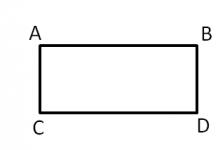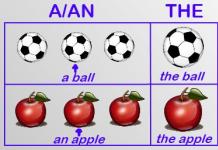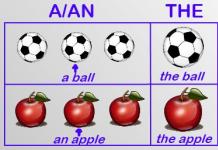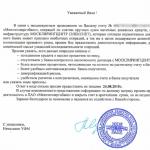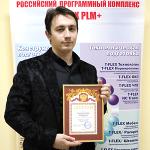Every parent wants their child to receive a full education and be a specialist in many fields, especially when it comes to foreign languages. Trying to give as much as we can, we often forget that it is sometimes difficult for children to understand some features of speech that they have not previously encountered. Articles are recognized as one of these difficulties on the path to improving knowledge. They are a connecting particle used with nouns, and help to more accurately determine what exactly is meant. Unfortunately, the array of information about the correct use confuses students, and therefore they use at their own discretion.
Let's look at articles in English together according to the rules for children in order to figure out what the main obstacles are. According to the traditional form, there are 3 classes of articles:
- uncertain(a and an),
- definite(the)
- And null.
So, let's take a closer look at the areas of their use.
Article "a" and "an"
Indefinite articles were transformed over time from the word “one” and differ from each other in that “a” is placed before consonants, and “an” is written next to vowels to maintain euphony.
Cases when their use is necessary:
- May be near countable nouns, filed in singular from a similar class: We saw a flower yesterday. – We saw the flower yesterday.
- If about something said for the first time: I had a new friend yesterday. – Yesterday I made a new friend.
- If by a word we understand the meaning as everyone or anyone, speaking as about fact: I’m writing with a pen in my notebook. – I write with a pen in a notebook.
- Meaning the word "one": I'll call you in an hour. - I'll call you in an hour.
- When we talk about the whole subject class(for example, about the class of animals, plants, etc.): Rose is a very beautiful flower. – Roses are a very beautiful flower.
- In situations where it comes to small particle something: I would eat a piece of bread. - I would like to eat a piece of bread.
We have already mentioned that the English language is quite difficult at first. Therefore, there are circumstances in which the indefinite article can also be used in the plural. There are also stable phrases that will be useful to you in the future:
- To be in a hurry
- To be at a loss
- To have a headache/ toothache
- In a loud voice
- In a whisper
- It's a pleasure.
You can present the rules in the format of a fairy tale, where the articles will be 2 brothers who set off on an adventure, and along the way they will find friends (suitable situations of use).
Article "the"
Derived from the words “those” [ðəʊz] – those and “this” [ðɪs] – this. Used with singular and plural nouns.

Rules for using the article “the”:
- If we understand what we are talking about because it was mentioned earlier, or we guess: He wants to drive. They go to the cars. - He wants to drive. They go to the cars.
- The story is about a unique subject: The sun rises in the east. – The sun rises in the east.
- Next to a noun meaning a type, genre, variety of something: The apple tree grows everywhere. – Apple trees grow everywhere.
- Exception: the word “man” in the meaning of a biological species.
- In context with the words “last” and “next”: The next summer promises to be warm. – Next summer promises to be warm.
- Together with adjectives as nouns: The strong must help the weak. – The strong must help the weak.
- If we mean some common place that everyone knows about (hospital, store, etc.): The hospital is on my street. The hospital is on my street.
- Among the instruments of music: My hobby is playing the guitar. – My hobby is playing the guitar.
- Before different nationalities: The Russians are very cheerful people. – Russians are very cheerful people.
Zero article
At its core, the zero article presupposes its absence in principle. Here are a few points when you need it:
- With uncountable and abstract nouns: Happiness is something you can’t buy. – Happiness is something you can’t buy.
- With plural countable nouns: She brought apricots. - She brought apricots.
- With proper names: Eva is the smartest girl. – Eva is the smartest girl.
- If there is a demonstrative and possessive pronoun before it:
- I liked this album. – I liked this album.
- I reminded my friend about homework. -I reminded my friend about his homework.
Learning articles in English according to the rules will be a little boring for children, so think in advance about how to diversify the process. Perhaps these will be riddles, competition tasks. Ask the children to draw examples of cases where we use one of the articles.
In this lesson we will consider the topic “Articles in English”. Let's study what articles exist and the basic rules of use in constructions. The analysis is carried out at a level understandable for children and adults.
The use of articles together with nouns in English is a rather voluminous topic, so you should be patient.
In English, the article (The Article) is the main definition of nouns. When constructing a sentence, the first thing they start with is thinking about articles, the speaker defines a definite or indefinite noun and then puts the articles. In other words, we are talking about something specific or something general. There are no articles in the Russian language, which is why this topic causes certain difficulties for many.
When composing a construction in English, the article is used in almost all cases. There are:
- The Definite Article or the definite article to which it refers The;
- The Indefinite Article or indefinite article, which refers to an And a.
We will study 3 cases of using the article - the use of the indefinite, definite article and cases when the article is not used at all in the construction.
Definite Articles in English (The Definite Article)
This part of speech has only one form, the. From a grammatical point of view, it comes from the demonstrative pronoun “that - that”.
- The definite article The Definite Article is used in a sentence when talking about an object that has already been talked about or in cases where the interlocutor understands what the conversation is about.
For example, Please show me the book. - Show me this book, please. - This part of speech is also used in a sentence when interlocutors talk about an object that is one of a kind.
For example, The sun is in the sky. - The sun is in the sky. - applies in all cases when interlocutors talk about a musical group, newspaper, cinema, restaurant.
For example, The Beatles - The Beatles. - The name of nationality, when not talking about someone specific, but generalizing all representatives of the clan, is used with the part of speech in question.
For example, the Americans. - Americans. - The definite article is used in some phrases.
For example, at the cinema/ the theater - to the cinema/theater. A stable design was used here. - If a proper name contains the words kingdom (kingdom), union (union), republic (republic), this article is used together with them.
For example, The United Kingdom - United Kingdom. - This part of speech is used in sentences after prepositions of place.
- If there is a construction “next, last + some time period,” we put this article in front of the entire construction.
For example, the next day - the next day.
For example, There is a cat in front of the monitor. – There’s a cat in front of the screen. - If we are talking about the whole family, then the article in question is also placed before the surname.
For example, The Petrovs are at home. - Petrov's houses. - objects are also used in construction with the part of speech in question.
For example, the Arctic - Arctic and the Alps - Alps.Attention, the article is not used in the names of countries, streets, airports, islands.
- If a proper name is expressed by a title and after it there is such a meaning of, the article in question is used.
Example, The Prince of Wales - Prince of Wales. - In English, as in Russian, there is an adjective that is used without a noun, but denotes a group of people. This form should also be preceded by this part of speech .
For example, The old - old people. - If the construction contains a superlative adjective, articles definite are also used before it.
Example, the quickest - the fastest. - The is used whenever there is an "of" before the noun.
For example, The Tower of London - Tower in London. - With cardinal points, this article is always used in the design.
For example, the Northern part of our country - the north of our country. - If the sentence contains the word only (meaning only), then here we also use the article in question.
For example, She was the only beautiful woman in his life. - She was the only beautiful woman in his life. - And the last case of using articles is before an ordinal number.
Example: We are on the fourth floor. - We're on the fifth floor.
This article in question is used with nouns used in the singular and plural.
Indefinite article
Views: 1,119
Articles in English are simple and clear.
Articles are perhaps one of the most incomprehensible phenomena for schoolchildren learning English. Most of them use articles intuitively. And this choice is not always the right one. How to explain to a child the rules for using articles without burdening them with complex terminology and lengthy explanations?
Of course, it is impossible to simplify everything down to the elementary level. However, the basic level can be presented simply and clearly. It is unlikely that all children will understand and remember all the points of the rule given to them in one lesson. Therefore, in the future, the teacher should draw students’ attention as often as possible to cases of using articles and correlate them with the points of the previously given rule. For better memorization, it is advisable to place some of the following diagrams and tables in the article in the classroom.
The first thing students need to learn is that there are three articles in the English language: a/an, the and the zero or significant absence of an article. Next, you need to justify the use of each of them.
The indefinite article a/an can only appear with a singular countable noun.
SCHEME 1:
a /an + countable noun in units h.
A - before a consonant sound (namely a sound, not a letter), an - before a vowel sound.
SCHEME 2:
a + acc. sound (a dog; a year)
an + v. sound (an aunt; an hour)
What to use in the same position if the countable noun is plural? In this case, many children try to change the indefinite article to the definite article, making a typical mistake. Therefore, students must immediately be explained that in this case the indefinite article must be changed to zero. But definite has a completely different meaning. In this case, the definite article can be used both with a singular and plural noun. The same applies to the zero article.
Next, we need to explain the difference in the meanings of the articles. The indefinite gives the following meanings to an object called a singular countable noun: one; one of; one of, and therefore all like him; some; some; uncertain; any.
SCHEME 3:
The definite article gives the following meanings to an object called a noun (singular or plural): specific; known to the speaker; unique, unique; the only possible one in this case; exactly this one; clear from the context.
SCHEME 4:

The zero article can have almost the same meaning as the indefinite article, but is usually used with countable nouns in the plural or with uncountable nouns in the singular and plural. The meanings of the zero article are: generalization; lack of specifics; typicality; uncertainty.
SCHEME 5:

If a student uses an article incorrectly, he should be asked to replace it with the meaning from the corresponding diagram. Then the mistake will become obvious, and he will be able to more correctly select the desired article.
At the next stage, it is important for children to remember more detailed cases of using articles, each time relating them to the rule.
INDEFINITE ARTICLE
There are a number of grammatical structures in English that require the use of the indefinite article that need to be memorized. Many of them contain the linking verb to be in the singular in any tense or the verb to have (got). In the following table we will take the Present Simple tense.
Smth/smb is
(My father is a doctor.)
+a/an
countable noun in units number
This/that is
(This is a car.)
There is
(There is a box under the table.)
Smb/smth has got
(Sam has got a dog.)
You need to remember the following expressions:
a lot of;
once (twice, three times ...) a day (week ...);
such a/an + ex. noun Ved. number.
And also exclamatory sentences like: What a fine day! They also contain a singular countable noun.
At this stage, there is enough information about the indefinite article.
DEFINITE ARTICLE
Cases of using the definite article do not always fit into standard patterns. There's a lot to remember here. However, some trends can be identified.
The article the is needed with the following names:
1) rivers, seas, oceans (the Volga, the Baltic Sea, the Atlantic Ocean);
But! Lakes and ponds do not need an article if their name contains the word lake: Lake Baikal - The Baikal.
2) countries formed from several component parts (the USA, the UK, the Russian Federation) or countries whose names are in the plural (the Netherlands);
3) museums, cinemas, theaters and other similar institutions (the Odeon, the British Museum);
4) mountain ranges (the Urals);
5) clusters of islands (the British Isles);
6) the surname of the whole family (the Wilsons);
7) nationality (the British).
In most cases, in that part of the sentence that answers the questions “Where?”, “Where?” (adverbial circumstance), you need to use the definite article. My desk is in the corner. We went to the cinema.
Superlative adjectives and ordinal numbers require the definite article. Bill is the best driver I have ever seen. It's the second lesson.
The repeated mention of the thing denoted by the noun is the reason for the use of the definite article. I have got a cat. The cat is fluffy.
The following words and expressions need to be remembered:
1) by the way;
2) the same;
3) play the piano (and other musical instruments);
4) in the morning, in the afternoon, in the evening;
5) on the left, on the right;
6) the sun, the moon, the earth, the sky.
Of course, this applies to all cases of using the definite article. However, most of them fit well into the positions DIAGRAMS 4.
ZERO ARTICLE
A significant absence of an article is required before nouns that name:
1) names (William);
2) surnames in the singular (Johnson);
3) countries (Russia);
4) parts of the world (Europe);
5) continents (North America);
6) cities (Moscow);
7) single islands (Madagascar);
8) mountain peaks (Everest);
9) streets (Green Street);
10) square (Red Square);
11) parks (Hyde Park);
12) school subjects (Maths).
The zero article is used in the following expressions if their meaning does not contradict SCHEME 5:
at night, at noon;
in summer (winter, ...);
play football (tennis, ...);
have breakfast (lunch, ...).
If a noun is preceded by a possessive or demonstrative pronoun, then the article is zero ( this house, my car).
If after a noun there is a cardinal number that names a number, then the article is zero (room five, page six).
This knowledge constitutes a basic level, which is sufficient for students to be able to successfully use articles. In high school, you can study this topic in more depth.
Add to favorites
Indefinite article a/an in English (the indefinite article) has two forms:
a[ə] - used before consonants. That is, if a word begins with a consonant, use a:
a b ook, a t able, a m an a g irl a c computer, a t omato, a yacht [ jɒt], a unit [ ˈj uːnɪt]
an[ən] - used before vowels. That is, if a word begins with a vowel sound, use an:
an a pple, an e ngineer, an i dea, an o range an a nswer, an hour [ˈ aʊə(r)]
Please note that the choice of the form of the indefinite article is determined not by spelling, but by pronunciation.For example, the word hour starts with a vowel sound, so we use the article an (an hour), although the first letter in writing is a consonant h. Or, for example, the word yacht (yacht) written with a vowel y, but the consonant sound [j] is pronounced, so we choose a (a yacht). Using different forms of the same article helps make speech harmonious, easy, and natural. Try to pronounce an apple or an book, and you will feel how difficult and uncomfortable it is.
Remember:
Indefinite article a/an used only with singular:a pen(pen), a story(story), a chair(chair), a child(child), a flower(flower)
If the noun is used in the plural form, then there is no indefinite article. The absence of an article before a noun is usually called the "zero article".
pens(pens), stories(stories), chairs(chairs), children(children), flowers(flowers)
When to use the indefinite article a/an
Below you will find a description of the main uses of the indefinite article a/an in English.
№1
Indefinite article a/an used when we first mention an object or person. In this case, we assume that our interlocutor does not know what or who exactly we are talking about.
Yesterday I bought a handbag. — Yesterday I bought a handbag.
Up until this point, I hadn’t even talked about how I was going to buy a bag. That is, I mention this for the first time (my interlocutor knows nothing about this bag), hence the indefinite article a/an.
If you continue to talk about this bag, then the noun handbag (bag) will already be used with the definite article the, since this time the interlocutor knows which specific bag we are talking about:
Yesterday I bought a handbag. The handbag is very beautiful. — Yesterday I bought a handbag. The handbag is very beautiful.
Although most often a personal pronoun is used instead of a noun, it sounds more natural and avoids repetition:
Yesterday I bought a handbag. It is very beautiful. — Yesterday I bought a handbag. She is very beautiful.
№2
Indefinite article a/an is used when we are not talking about a given (specific) object or person, but simply about any, some, one of a group of the same objects or people. In other words, when we talk about an object or person in general, without having a specific one in mind skirt, work, handle or dog:
I want to buy a skirt. — I want to buy a skirt. (some kind of skirt, I don’t know which one yet; I only know that I want a skirt, not a dress)
He refused to look for a job. — He refused to look for work. (some kind of work)
Give me a pen, please. - Give me a pen, please. (any, any)
It is a dog. - This is a dog. (some dog, any dog)
When we are not talking about a specific object or person, but about anyone, then further, if we need to re-designate it, we do not use personal pronouns or the definite article the. And again we use the indefinite article a/an or pronoun one.
She wants a car but he says they don’t need one. “She wants a car, but he says they don’t need it.”
or
She wants a car but he says they don’t need a car. — She wants a car, but he says they don’t need a car.
She wants to have a car (not a motorcycle, not a bicycle, but some kind of car, so a car), but he says that they don’t need a car (they don’t need any car at all, not just a specific one). Since in the second part of the sentence we are again talking about any / indefinite machine, we again use a car.
№3
Indefinite article a/an we also use it to describe or give any information about something that has already been mentioned earlier. In this case, an adjective is often used before the noun. Please note that although the article comes before an adjective, it refers to a noun:
It is a beautiful place. - This is a beautiful place. (describe what this place is)
He is a clever boy. - He's a smart boy. (we characterize what kind of boy he is)
Do you live in a big house? — Do you live in a big house? (we ask which house)
When we talk about a person’s profession or work, we also use the indefinite article a/an:
She is a teacher. - She is a teacher.
I am a doctor. - I am a doctor.
№4
Historically indefinite article a/an came from the numeral one (one). Hence the possibility in some cases to replace the article a/an numeral one. Such a replacement is possible when the article a/an essentially means "one". For example, this meaning of the indefinite article is observed in numerals a hundred (one hundred), a thousand (thousand), a million (million) and in the word a dozen (dozen) when they are used independently or before a noun:
This toy costs a thousand roubles. = This toy costs one thousan d roubles. — This toy costs a thousand rubles (one thousand rubles).
Give me a dozen, please. = Give me one dozen, please. - Give me a dozen, please (one dozen).
It is precisely with the origin from the numeral one (one) and the meaning of the singularity of the indefinite article is associated, which is especially evident when expressing measures of time, distance, weight or quantity:
This chocolate bar costs a dollar. — This chocolate bar costs a dollar. (=one dollar, we can replace a dollar on one dollar)
I'll call you in an hour. - I'll call you in an hour. (=in one hour, we can replace an hour on one hour)
Can I have a kilo of tomatoes, please? — Can I have a kilogram of tomatoes, please? (=one kilogram, we can replace a kilo on one kilo)
Please note that the numeral one instead of an article a/an should only be used when you want to emphasize that you are talking about just one thing or person, that is, when you want to be very precise:
I have got one sister. - I have one sister. (not two sisters, not three, but only one)
I have got a sister. - I have a sister. (in this case I just say that I have a sister)
The meaning of the singularity of the indefinite article can be seen in some stable phrases that convey the one-time action:
have a look- take a look
have a snack- have a snack
have a try- try, try
have a rest- relax
have a good time- have a good time
give a chance- give a chance
give a hint- hint
give a lift- give me a ride
make a mistake- make a mistake
play a trick- play a trick
№5
Indefinite article a/an also used when it is necessary to indicate the quantity per unit of measurement. For example, when we talk about the price of oranges per kilogram, the amount of wages per month, the number of classes per week, or the speed of a car per hour. A noun denoting this same unit of measurement will be used with the indefinite article.
The oranges were 80 rubles a kilo. — Oranges cost 80 rubles per kilogram.
She works 8 hours a day. — She works 8 hours a day.
I go to aerobics twice a week. — I go to aerobics twice a week.
№6
Indefinite article a/an can also be used with some uncountable abstract nouns (for example, humor - humor, hatred - hatred, anger - anger, magic - magic) in the case when they have an adjective with them. Typically, such use of the indefinite article is characteristic of book style and expresses the author’s desire to emphasize the individual, special character of this or that abstract concept.
Please note that in the above case, the use of the indefinite article is optional. If you do not want to highlight in a certain way the special character of any emotion, character trait, etc., the article a/an may not be used.
On a note
To learn to use the indefinite article a/an more or less automatically, try to form a rule in your head: use the indefinite article with singular countable nouns when there is no other reason for using the definite article the or some other determiner (possessive or indefinite pronoun).
is a word that provides some information about a noun. The article is found in all European languages. There is no article in the Russian language and therefore the topic “Article” is the most difficult when learning English.
Total in English two articles:
a(an)- uncertain;
the- definite.
A COMMENT
- Article a(an) came from the word “one” (one) and makes sense — one, any, some.
- Article the comes from the word “this/ these” (this, these) and makes sense — this, these, specific(s).
- a table (units) - one table
- an apple (singular, before a vowel) - one apple
- the table (singular) - this table
- the tables (plural) - these tables
Article in English (rules for beginners)
Basic rules for using the article:
Rule 1 (general)
- Article a(an - before a vowel) is placed only before a noun singular , if it is mentioned for the first time.
- Article the comes before a noun in any number ,
if it is mentioned second or more times in meaning "this".
- I see a girl. The girl is nice. - I see a girl. (This) girl is cute.
- I see boys. The boys are tall. - I see boys. (These) boys are tall.
COMMEHTAPY: If a noun is preceded by an adjective, the article is placed before it.
- a story
- an interesting story
COMMEHTAPY: Article a(an) NOT placed before a noun plural, and the article the is placed.
- an apple - apples (one apple - apples)
- the apple - the apples (this apple - these apples)
Rule 2. No article is used, if the noun is preceded by:
- numeral - two cats (two cats);
- possessive pronoun - my cat (my cat);
- noun in the possessive case - the boy's cat (boy's cat);
- demonstrative pronouns this, that- this that;
- negative particle NO: I have no cat(I do not have a cat).
Rule 3. Article a(an) OFTEN placed in sustainable structures:
- It is a… + noun (singular) - Not translated,
- This is a... + noun (singular) - This is ...
- There is a... + noun (singular) - There is ...
- It is a table. It is a big table.
- This is a cat. It is a clever cat.
- There is a bird in the bush, There is a little bird in the bush.
RULE 4. Article the is placed before:
- noun the only one in this situation: the floor (floor), the sun (sun)
- OFTEN before noun - subject: The book is...
- before ordinal numbers: the first (the second, the third) ... - first, second, third, etc.
- before superlative adjective: the best (the worst) - the best, the worst, etc.
